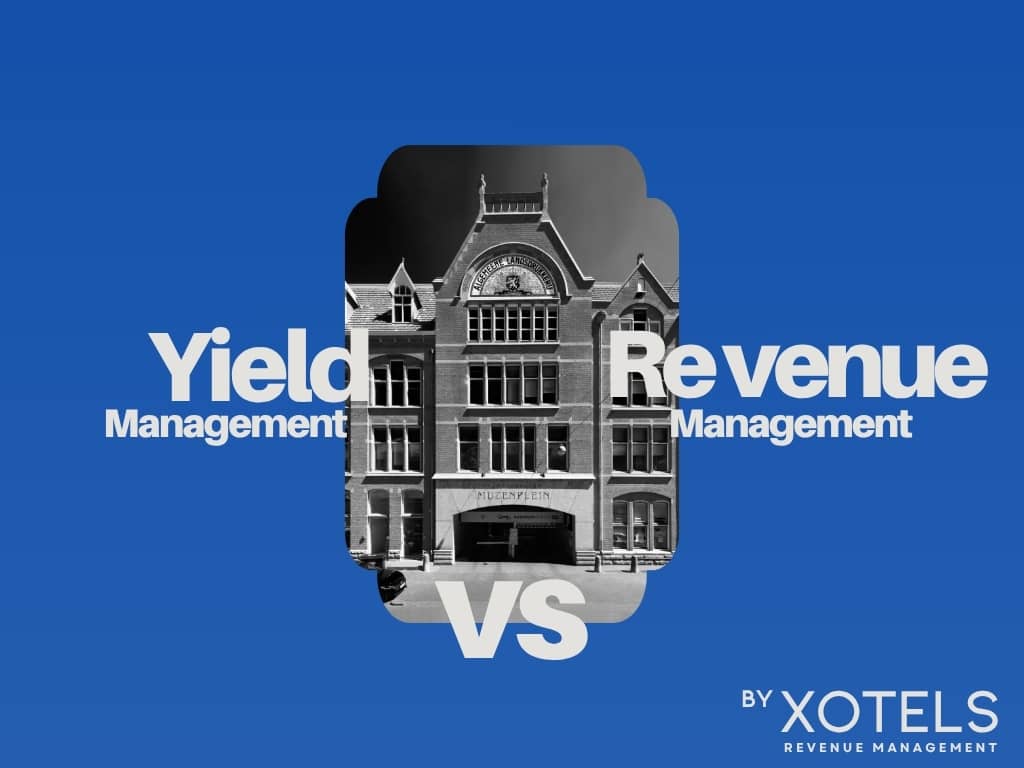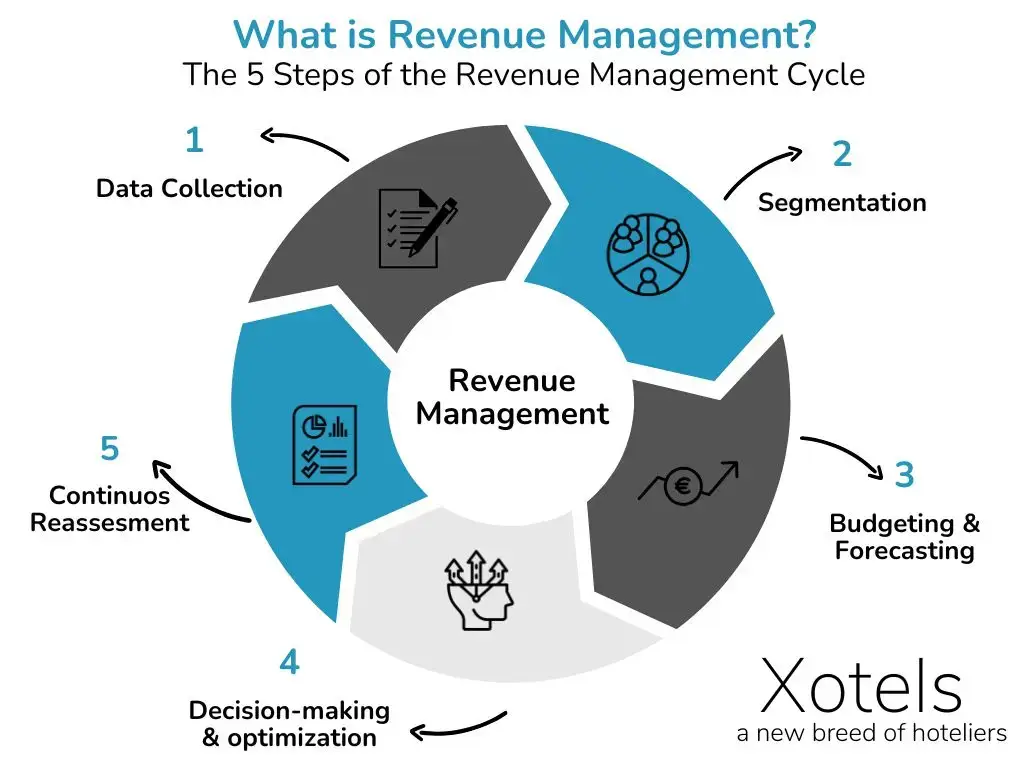Top Hotel Revenue Management Strategies
We have written extensively about hotel revenue management strategies and tactics here throughout the years. As strategy is one of the most essential parts of revenue management, we have made a summary of all the top advice from our perspective as a hotel revenue management consulting company.
We have written extensively about hotel revenue management strategies and tactics here throughout the years. As strategy is one of the most essential parts of revenue management, we have made a summary of all the top advice from our perspective as a hotel revenue management consulting company.
We have written extensively about hotel revenue management strategies and tactics here throughout the years. As strategy is one of the most essential parts of revenue management, we have made a summary of all the top advice from our perspective as a hotel revenue management consulting company.
Article Summary
- What is Revenue Management?
- Benefits of a Good Revenue Management Strategy
- +14 Revenue Management Strategies
- Encourage Direct Hotel Bookings
- Understand your Market
- Guest & Market Segmentation
- Demand Calendar
- Forecasting Strategies
- Booking Curves
- Pricing Strategies & Calculations
- Unconstrained Demand
- Benchmarking
- Generate Ancillary Revenue
- The Value of Data
- Outsource Revenue Management
- Distribution strategy: Fish Where the Fish Are!
- Collaboration with other departments
- The Future: Total Revenue Management
What is Revenue Management?
In our article about What is Revenue Management and in our Free Revenue Management Book for Hotels we have explained everything in detail about what the concept of revenue management is all about.
In short, revenue management is a disciplined approach that aims to increase the revenue success of your business. This is done by thoroughly understanding your property, its customers, and the market.
Many define itt as: “Selling the Right Room to the Right Client at the Right Moment at the Right Price.”
At XOTELS, we like to be even more specific, so we add: “On the Right Distribution Channel with the best commission efficiency”.
Benefits of a Good Revenue Management Strategy
For any hotel, a revenue management strategy is a fundamental pillar. Following best practices and a well-thought-out strategy is the only way to unlock the full potential of revenue for your hotel, with benefits including:
- Claim your fair market share: with more hotels forecasted to open every year, gaining a fair market share will become more difficult each year. Without a solid revenue management strategy, a hotel will just get lost in the pile of other hotels – being unable to reach satisfactory visibility and level of business to remain open.
- Seize the right opportunities: opportunities are abundant – but trying to find the right distribution mix and deciding which opportunities to target is where hoteliers get lost in the giant maze of channels available. Also, gone are the days of selling the majority of your rooms through OTAs. Without a healthy distribution mix including a strong website and direct sales, you can forget about your profit margins.
- Take full advantage of the available demand: of course, we know that flat pricing is not how hotels can maximize their revenue, but what lies at the other end of the spectrum? You cannot just apply different prices and restrictions per day without a plan in place – as you can easily do more harm than good.
15+ Essential Hotel Revenue Management Strategies:
Find below top list of revenue management strategies to take your hotel to the next level – and increase your performance:
1. Encourage Direct Hotel Bookings
Encouraging customers to book directly should be a main priority included in your revenue management strategy. Making sure you get your fair share of direct bookings allows you to compete with OTAs and avoiding to pay the hefty commissions on those bookings.
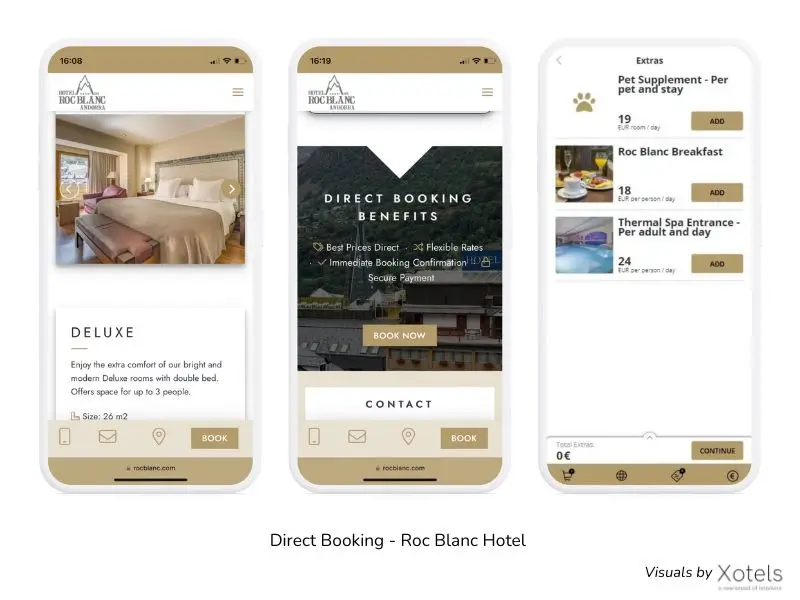
There are several recommended best practices to follow to boost your direct bookings, namely:
- Invest in a great website: build a well-designed and good-looking website, that is fast (for every second delay in page load, conversions can fall by up to 20%), user-friendly and is also optimized for users using their mobile phones. Make sure you have the best content available, and that all information is accurate and up-to-date ensures a seamless user experience.
- Incentivize: having the best prices on your website is one things, but don´t forget to think about offering other exclusive benefits or extras to encourage users to book on your website and not the OTAs.
- Bring customers to your website: thinking multi-channel here is important. How to bringing in traffic to your website from platforms like Google Ads, Metasearch, SEO, and social media, will need to be part of your strategy to generate revenue.
Ultimately, prioritising achieving a fair share of direct sales empowers hotels to establish stronger control over guest data to increase profitability, and maintain autonomy over their brand image and customer experience.
2. Understand your Hotel´s Market
The success of your revenue management strategy depends on how well you understand your market. This is one of the first steps when creating a revenue management strategy, performing thorough market research. Questioning when and where your demand will come, who will be booking at your property, which hotels will you have to compete, and identifying challenging periods or seasons are important to manage expectations. Mapping out these questions out in your strategy will help to set realistic goals.
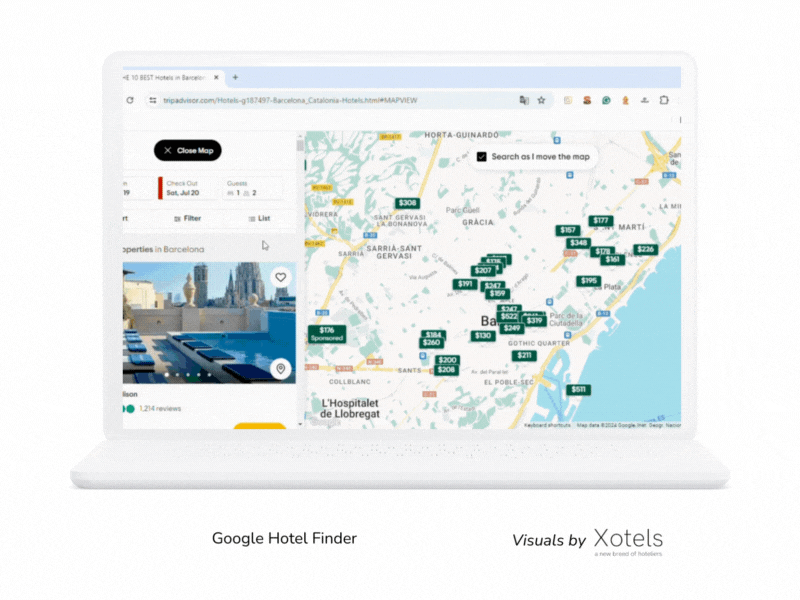
3. Guest & Market Segmentation
Hotel market segmentation is an important component of effective revenue management, allowing hotels to target diverse consumer groups based on their behaviours and budget levels. This segmentation involves identifying the purpose of the trip, differentiating between business and leisure travellers, and analysing various trends to enhance revenue performance. Key factors considered in market segmentation include length of stay, day-of-week stays, total revenue per room, total revenue per client, booking lead time, cancellation percentage, and no-show ratio. By understanding these factors, hotels can tailor offers to meet the specific needs of different segments.
| Guest type | Characteristics | Targeting opportunity |
|---|---|---|
| Leisure | Customers travelling for the purpose of enjoying leisure activities, such taking a weekend break, or extended holiday. Although exceptions exist, such as resorts and rural destinations, demand from this guest type is especially strong during weekends and holiday periods. | Focus on what leisure travellers want to add value to their stay. For example, highlight amenities (bar, restaurant, spa, pool), and leverage packages (romantic, weekend, spa offer), to both expose why bookers should stay at your hotel, and generate ancillary revenue by promoting those offerings. |
| Business | Typified by strong weekday demand, obviously as these travellers conclude their business during the week and head home for the weekend. | - Cater to this audience with relevant amenities such as fast Wi-Fi, a comfortable place to work in the room, etc. - Your revenue strategy should cover special (contracted) rates. |
| Long-stay | Long stay guest can travel both for work purposes, as well alternative scenarios such as remote work or temporary housing during a relocation. | - Make smart use of length of stay that encourages these bookers to book and stay with you, and not through OTAs or competitors. - Long-stay amenities (kitchenette, in-room working/living area etc.). |
| Bleisure | Also defined as a “bizcation” or “workcation”, travellers typically refers to corporate travellers which also add leisure activities into their stay. | Mix of business and leisure amenities and services (see how to target the bleisure market). |
| Groups | A unique segment consisting of reservations generally consisting of more than 5 or 6 rooms (make sure to stipulate this in your conditions depending on the hotel size and revenue strategy). | - Have both on and- offline marketing/sales content available to entice group stays. - Revenue management should lead the pricing strategy to ensure the best offer goes out to the booker. - Have group conditions implemented, and listed clearly on your website and other channels. |
Each hotel must customise its segmentation strategy based on its market, property, and revenue management goals. So which main segments can different hotel types expect, you might ask? Here is an example:
| Main Segments per Hotel Types by XOTELS | |||||
|---|---|---|---|---|---|
| NAME | BAR | CORPORATE | TOUR OPERATORS | PROMOS | ALLOTMENT |
| City Hotels | X | X | X | ||
| Resorts | X | X | X | ||
| Conference Hotels | X | X | X | ||
| Airport Hotels | X | X | X | X | X |
| Extended Stay/Apart-Hotels | X | X | |||
| Hostel | X | X | |||
| Motel | X | X | X | X | |
4. Demand Calendar
The demand calendar is a tool that helps to make informed pricing strategies in hotel revenue management. For analysing market situations, the demand calendar includes key indicators such as RevPAR (Revenue Per Available Room) and demand levels from the previous year, along with factors like groups or events, bank holidays, school holidays, and exceptional demand indicators for the current year.
Obtaining data like RevPAR and event information is relatively straightforward from internal PMS data, but determining the impact of school and bank holidays involves analysing arrival statistics from feeder markets. This information enables revenue managers to strategically target specific holidays or events with tailored offers and packages. Integrating demand calendar data into on-the-books and pick-up summaries provides a comprehensive view of the hotel’s trends, ultimately facilitating better-informed decisions and more effective hotel revenue management strategies.
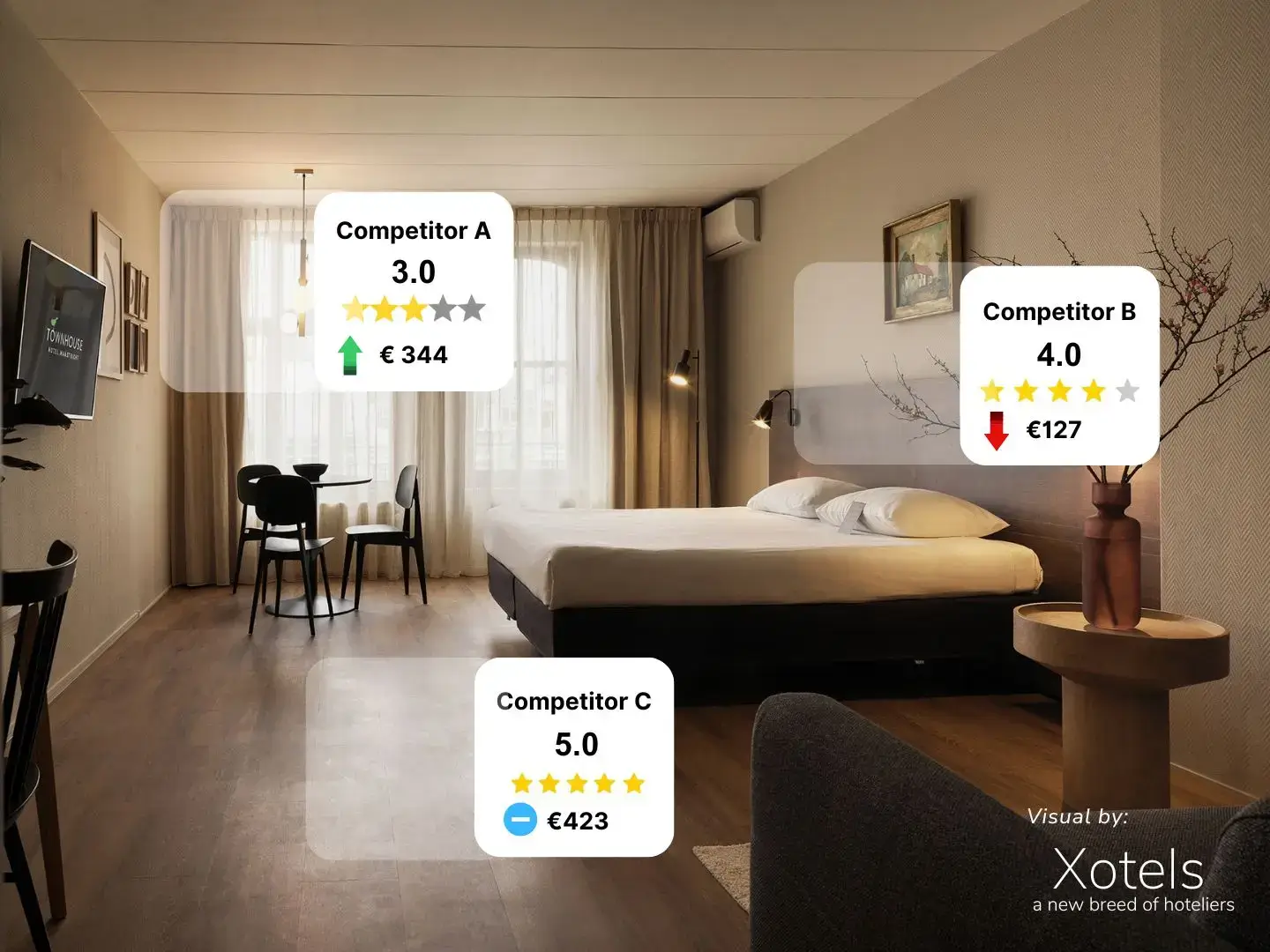
5. Forecasting Strategies
Effectively forecasting hotel revenue is an activity all managers should perform, particularly in the face of evolving challenges associated with changing reservation lead times in key markets. A comprehensive approach is necessary because of the integration of diverse forecasting methods to generate a thorough and resilient analysis. Operational, financial, and revenue management forecasting are distinct yet essential contributors to revenue optimisation.
Hotel Revenue Management Systems (RMS) can be used for effective forecasting, as this is equipped with advanced algorithms to enhance precision in forecasting. Key focus areas for successful forecasting include leveraging historical data, scrutinising on-the-book (OTB) data, and considering market trends. The ultimate goal is to achieve a maximum forecasting accuracy of 5%, continually examining differences and identifying root causes for ongoing improvement. Using a Hotel Forecasting Model is a good way to prevent and identify challenges in reaching your objectives: it gives time to adapt strategies or work out additional actions.
Read the full article about How to Forecast Hotel Revenue with Optimized Precision.
6. Booking Curves
The Hotel Booking Curve is a hotel tool that helps aid in data-driven decision-making. Converting pick-up reports into graphs, particularly a Booking Curve graph, helps visualise the hotel’s booking pace. The graph considers cancellations and identifies peak or slow booking days. If expectations are unmet, the hotel should analyse, understand, and determine if influencing factors can be addressed. Assessing the impact of rate changes on the forecast is essential, as the selling strategy directly affects it. Developing a revenue management tool for comparing data, such as comparing current bookings to the same day in the previous year, helps refine strategies and maximise opportunities.
7. Price Positioning & Strategy
A Rate or Price Value Matrix serves as a valuable tool for evaluating the effectiveness of a hotel’s pricing strategy. This matrix prompts reflection on how frequently the hotel’s rates align with or deviate from competitors. The four outlined pricing strategies – penetration, equality, surrounding, and skimming – offer distinct market positioning approaches. Penetration emphasises affordability, requiring careful consideration to avoid lowering overall market rates. Equal pricing focuses on comparable rates, with the hotel’s value proposition as the key differentiator. Surrounding pricing strategically combines competitive rates with added value while Skimming positions the hotel among the most expensive, demanding a clear demonstration of superior value. Choosing a pricing strategy aligned with the hotel’s objectives and market dynamics and regularly reassessing it ensures optimal revenue management decisions and customer satisfaction.
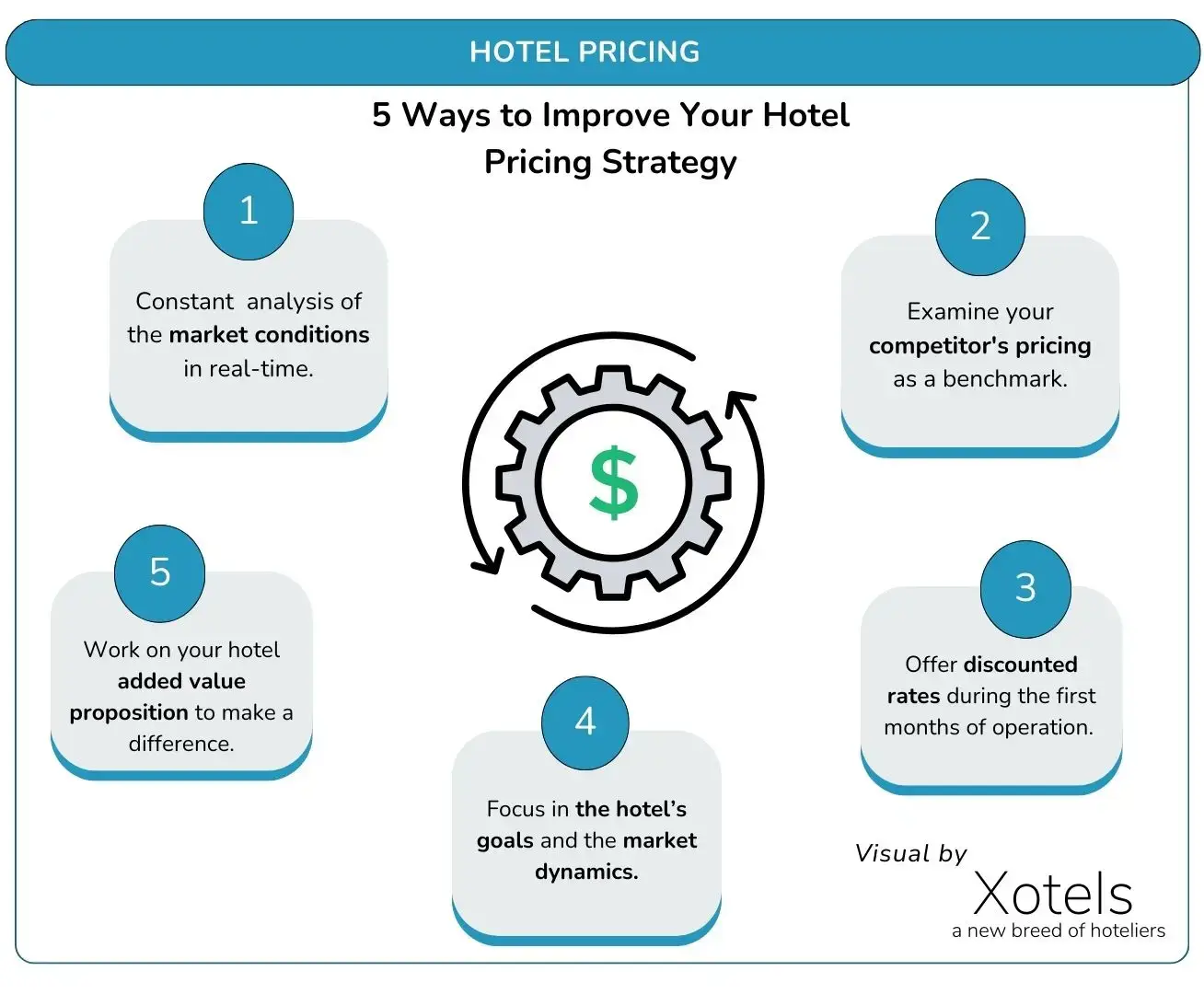
a. Stay Controls
Stay controls identify fully booked days and optimise revenue potential on shoulder days. Revenue managers should analyse past booking patterns, referencing the guest in-house list from the previous year, including denials and regrets, to understand stays of varying lengths. Various stay restrictions, such as minimum length of stay, maximum length of stay, combinations of minimum and maximum lengths, closed to arrival, closed to departure, and stay through restrictions, offer strategic tools for managing bookings. Implementing these restrictions requires evaluating the revenue impact on shoulder days, emphasising the need for careful consideration when selling out specific days.
b. Rate Fences
In hotel revenue management, the challenge lies in optimising product offerings through physical and non-physical rate fences. This means examining the compatibility of superior room types with consumer needs and evaluating the perceived value of specific features that warrant higher rates. The strategy involves clear differentiation in inventory and the creation of “physical rate fences” to justify varied pricing based on competitive differentiators.
c. Inventory Management & Overbooking
When looking to maximise profits, having room availability data at your fingertips can give a hotel a competitive advantage, and optimise prices according the hotel inventory you have left on the books. Some examples include:
- Room block: for instance, a group of business people who wish to use the hotel’s conferencing facilities over a two- or three-day stay.
- Overbooking: although overbookings are often seen as a scary proposition, it’s an important strategy to maximise occupancy and achieve those elusive perfect fills. By selling more rooms than you have available on a given night, you can help avoid being left with empty rooms due to cancellations and no-shows. However, avoid having to walk guest – an unpleasant experience for travellers and staff alike. Limit your exposure by overselling based on cancellation and no-show patterns, reducing levels as the arrival date approaches.
d. Displacement Calculations
Understanding the impact of contracted non-yieldable segments on your hotel revenue is advised. The displacement calculation involves evaluating whether these segments contribute positively to the bottom line or displace potential revenues that could be generated through public transient rates. Last Room Value (LRV), representing the total value of the previous rooms to sell, is a key metric in this analysis. Regularly performing displacement calculations on significant accounts, including tour operators, corporations, consortia, and IDSs, is essential for revenue managers to optimise pricing strategies and maximise overall profitability by assessing revenue gains versus potential losses.
8. Unconstrained Demand
Unconstrained demand in hotel revenue management refers to the total demand for a date, irrespective of hotel capacity. Recognizing periods of excess demand is vital for revenue optimisation. It aids in calculating the Last Room Value (LRV), identifying peak periods, and prioritising high-paying business. This concept involves regretting low-paying businesses during peak demand, recording denials for individuals and groups, and monitoring competitors’ bookings.
9. Benchmarking
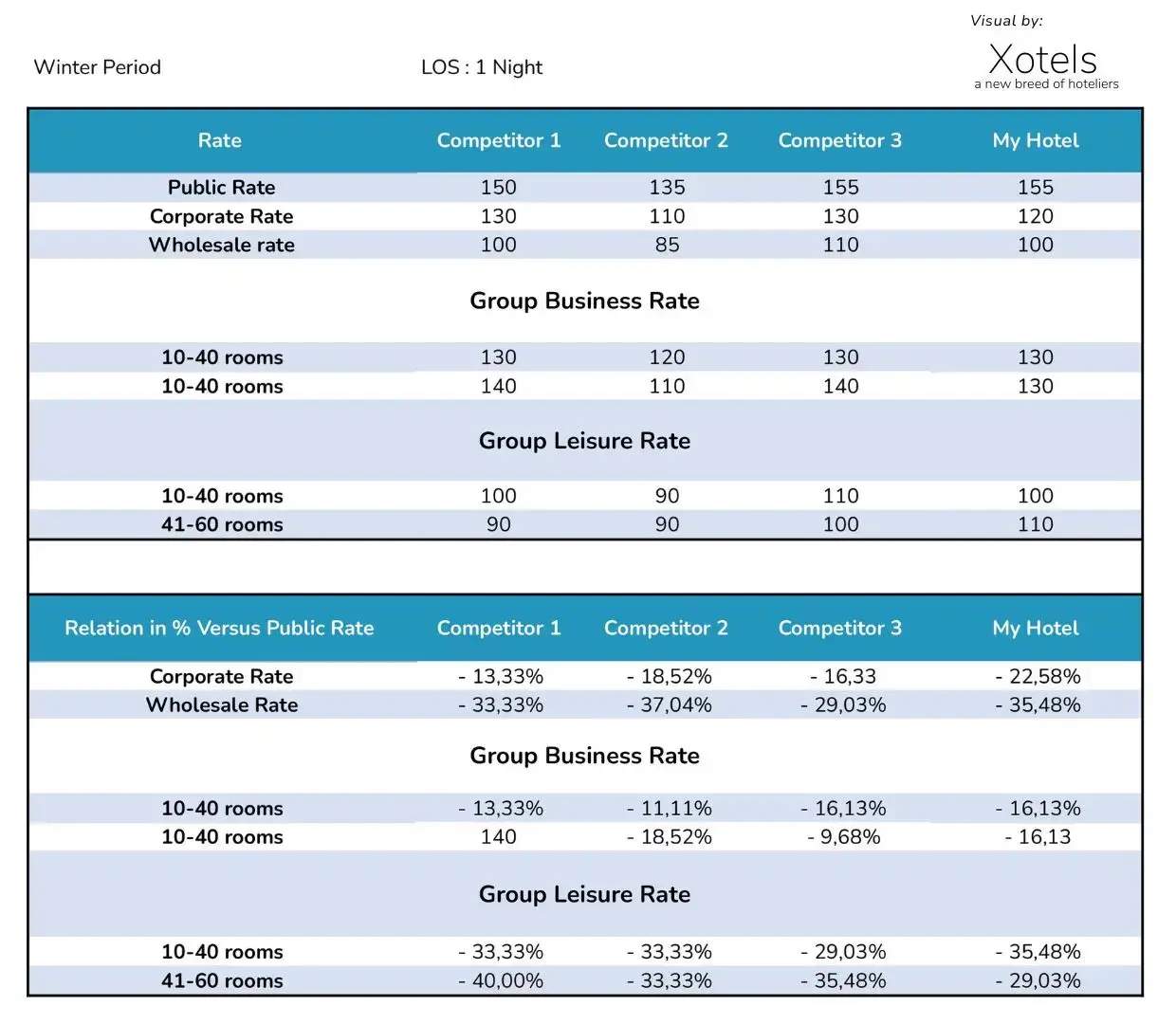
Benchmarking is a foundational element of revenue management. When benchmarking against competitors, it involves evaluating performance based on specific criteria, such as:
- Prices
- Product
- Level of service
- Location
- Distribution Channels
When doing a good benchmarking can be beneficial to provide valuable insights for performance improvement, strategic planning, and maintaining a competitive edge in the hotel industry.
10. Generate Ancillary Revenue
Understanding how to generate ancillary revenue for your hotel begins with understanding its meaning. Ancillary revenue refers to income derived from goods or services offered beyond the core accommodations offering. Besides enhancing profitability, it holds the opportunity to create a better guest overall experience due to the increased services/products provided. It involves employing upselling and cross-selling techniques, which include personalised recommendations, strategic pricing, and seamless integration into the guest experience.
In addition to these techniques, leveraging technology is essential for maximising ancillary revenue. This includes utilising booking platforms, CRM systems, and forming strategic partnerships and collaborations with service providers. Finally, an effective ancillary revenue strategy generation depends on adjusting pricing strategies, efficiently managing inventory, and targeting promotional efforts towards high-value segments.
11. The Value of Data: Gathering From Multiple Sources
Data is power, and keeping a database of high-quality data stands as a base for decision making and strategizing. Whether you get your data from your PMS, POS, reservation management systems, channel manager, booking engine, or other data collection tools, you can gain invaluable insights about customers and their behaviour, such as guest bookings, preferences, revenue figures, occupancy rates and feedback.
As hotels create a large amount of data each day, it is important to filter and create a data analytics report with the information that contributes to the growth in occupancy and revenue.
With a structured data collection and analysis process in place, you can make better data-based decisions, increase customer loyalty and satisfaction, and target customers with products and services that better suit them.
12. Outsource Revenue Management
By outsourcing revenue management, hotels can save money and increase earnings generation. Outsourcing enables hotels to utilise experienced professionals who specialise in complex tasks that require knowledge and experience to be performed well. Such hotel experts can assist hotels in identifying areas in which to reduce costs and increase profits, ensuring a healthy bottom line. Moreover, outsourcing allows hoteliers to focus on their core competencies, while the rest is taken care off. This not only saves time, effort and money, but it makes sure every detail of the business is in optimal shape and receives the attention it deserves.
13. Distribution Strategy: Fish Where The Fish Are
It is important to note that there are so many initiatives that hotels can engage in. However, making sure to fish where the fish are and testing different strategies before going all-in on a specific idea is vital. Setting clear objectives and prioritising the highest drivers of revenue is the way to go.
For example, keeping a close eye on your top producing platforms, such as Google Hotel Ads, ensures performance is kept consistent on the platform that bring the most value to your hotel.
With a laser-sharp focus on data and a clear understanding of the audience and goals, hotels can create revenue strategies that are both effective and efficient, thereby reducing costs that would be spent on ineffective campaigns. The key is to maintain momentum, and review if your your strategy needs adjusting or if certain strategies need to be changed or discontinued if results are lacking.
14. Collaboration with other Departments
Hotel departments should practice strong collaboration, period. Without teamwork, and leveraging each other knowledge and experience, a hotel will not be able to reach its full potential. Here are some examples of how collaboration can improve performance:
- Sales and marketing: Close collaboration with this department will ensure the revenue management strategists align with promotional offers and target markets, they can develop pricing strategies that benefit marketing campaigns and both will be driving revenue growth
- Operations: Understanding operational movements helps revenue managers make informed decisions about pricing and inventory management to optimise profitability, and also ensures that the revenue management strategists are aligned with the hotel’s capacity and capabilities.
- Finance: Collaborating with the finance department allows revenue managers to align revenue goals with financial objectives and budgets.
- Technology: Working with the IT department is essential for the effective implementation of tools in revenue management processes. Also, it helps to integrate the revenue management system with the other hotel systems, enabling efficient data exchange and automation of processes
The Future: Total Revenue Management
To wrap up this article, we can´t forget to look ahead at the future of revenue management strategies. Any hotel looking to improve its future performance should aim their strategy towards total revenue management. Put simply, it entails managing all revenue sources in a hotel. From your RevPAR and GOPPAR to the hotel restaurant, and from the bar, spa and gym to activities and excursions, it encompasses every single hotel income stream. Total revenue management is a whole topic on its own, so keep reading about Future of Revenue Management, Total Revenue Management to further understand this topic.
Start Building Your Winning Revenue Management Strategy!
We hope our advice has helped inspire and refresh your memory to create your own winning revenue management strategy.
Remember, it is all about outsmarting your competition. So, think of a stealth strategic revenue management action plan for your hotel that needs to be more transparent to the competition in your market. As experts in the field, our hotel revenue management consulting services can help you build, implement, and control your revenue strategy and turn your hotel into a market leader.
Cheers,
Patrick Landman
FAQs: Revenue Management Strategies FAQs
Share This Story, Choose Your Platform!

About the Author:
As CEO and Founder of XOTELS, Patrick Landman has made it his mission to turn hotels and resorts into local market leaders. XOTELS´ diverse expertise and deep-knowledge across revenue management consulting, hotel management, and hotel consulting, enables us to drive results for independent boutique hotels, luxury resorts, and innovative lodging concepts. Below you will find opinion articles written by Patrick Landman.







